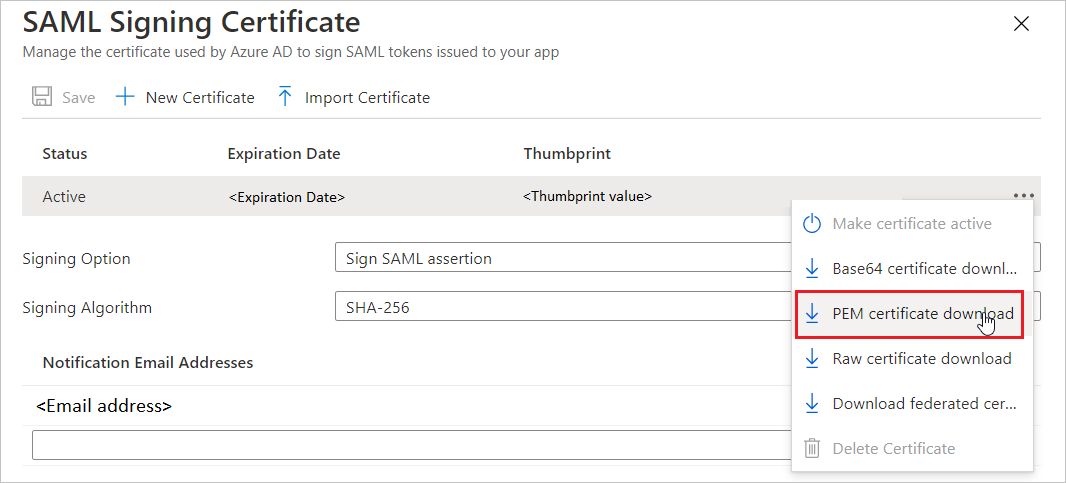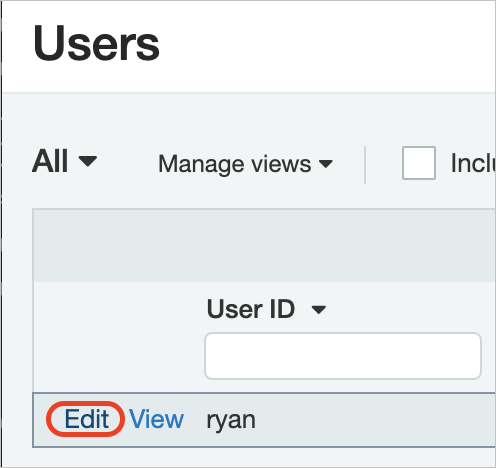In this tutorial, you’ll learn how to integrate Sage Intacct with Azure Active Directory (Azure AD). When you integrate Sage Intacct with Azure AD, you can:
- Control in Azure AD who has access to Sage Intacct.
- Enable your users to be automatically signed-in to Sage Intacct with their Azure AD accounts.
- Manage your accounts in one central location – the Azure portal.
In this tutorial, you configure and test Azure AD SSO in a test environment.
- Sage Intacct supports IDP initiated SSO.
Note
Identifier of this application is a fixed string value so only one instance can be configured in one tenant.
Add Sage Intacct from the gallery
To configure the integration of Sage Intacct into Azure AD, you need to add Sage Intacct from the gallery to your list of managed SaaS apps.
- Sign in to the Azure portal using either a work or school account, or a personal Microsoft account.
- On the left navigation pane, select the Azure Active Directory service.
- Navigate to Enterprise Applications and then select All Applications.
- To add new application, select New application.
- In the Add from the gallery section, type Sage Intacct in the search box.
- Select Sage Intacct from results panel and then add the app. Wait a few seconds while the app is added to your tenant.
Alternatively, you can also use the Enterprise App Configuration Wizard. In this wizard, you can add an application to your tenant, add users/groups to the app, assign roles, as well as walk through the SSO configuration as well. Learn more about Microsoft 365 wizards.
Configure and test Azure AD SSO for Sage Intacct
Configure and test Azure AD SSO with Sage Intacct using a test user called B.Simon. For SSO to work, you need to establish a link relationship between an Azure AD user and the related user in Sage Intacct.
To configure and test Azure AD SSO with Sage Intacct, perform the following steps:
- Configure Azure AD SSO – to enable your users to use this feature.
- Assign the Azure AD test user – to enable B.Simon to use Azure AD single sign-on.
- Create an Azure AD test user – to test Azure AD single sign-on with B.Simon.
- Configure Sage Intacct SSO – to configure the single sign-on settings on application side.
- Set up individual users in Intacct – to have a counterpart of B.Simon in Sage Intacct that is linked to the Azure AD representation of user.
- Test SSO – to verify whether the configuration works.
Configure Azure AD SSO
Follow these steps to enable Azure AD SSO in the Azure portal.
- In the Azure portal, on the Sage Intacct application integration page, find the Manage section and select Single sign-on.
- On the Select a Single sign-on method page, select SAML.
- On the Set up Single Sign-On with SAML page, click the pencil icon for Basic SAML Configuration to edit the settings.

- On the Basic SAML Configuration section, perform the following steps:a. In the Identifier (Entity ID) text box, type a unique identifier for your Sage Intacct company, such as
https://saml.intacct.com.b. In the Reply URL text box, add the following URLs:Reply URLhttps://www.intacct.com/ia/acct/sso_response.phtml(Select as the default.)https://www-p02.intacct.com/ia/acct/sso_response.phtmlhttps://www-p03.intacct.com/ia/acct/sso_response.phtmlhttps://www-p04.intacct.com/ia/acct/sso_response.phtmlhttps://www-p05.intacct.com/ia/acct/sso_response.phtml - The Sage Intacct application expects the SAML assertions in a specific format, which requires you to add custom attribute mappings to your SAML token attributes configuration. The following screenshot shows the list of default attributes. Click Edit icon to open User Attributes dialog.

- In the Attributes & Claims dialog, perform the following steps:a. Edit Unique User Identifier (Name ID) and set source attribute to user.mail and verify Name identifier format is set to Email address and click Saveb. Remove all default Additional claims attributes by clicking … and Delete.Attribute NameSource AttributeCompany NameSage Intacct Company IDname
<User ID>NoteEnter the<User ID>value should be same as the Sage Intacct User ID, which you enter in the Set up individual users in Intacct, which is explained later in the tutorial. Usually, this is the prefix of the email address. In this case, you can set the source as a transformation and use ExtractMailPrefix() on user.mail parameter.c. Click Add new claim to open the Manage user claims dialog.d. In the Name textbox, type the attribute name shown for that row.e. Leave the Namespace blank.f. Select Source as Attribute.g. From the Source attribute list, type or select the attribute value shown for that row.h. Click Oki. Click Save.Repeat steps c-i to add both custom attibutes. - On the Set up Single Sign-On with SAML page, in the SAML Signing Certificate section, click Edit to open the dialog. Click … next to the Active certificate and select PEM certificate download to download the certificate and save it to your local drive.

- On the Set up Sage Intacct section, copy the Login URL as you will use it within Sage Intacct configuration.

Create an Azure AD test user
In this section, you’ll create a test user in the Azure portal called B.Simon.
- From the left pane in the Azure portal, select Azure Active Directory, select Users, and then select All users.
- Select New user at the top of the screen.
- In the User properties, follow these steps:
- In the Name field, enter
B.Simon. - In the User name field, enter the [email protected]. For example,
[email protected]. - Select the Show password check box, and then write down the value that’s displayed in the Password box.
- Click Create.
- In the Name field, enter
Assign the Azure AD test user
In this section, you’ll enable B.Simon to use Azure single sign-on by granting access to Sage Intacct.
- In the Azure portal, select Enterprise Applications, and then select All applications.
- In the applications list, select Sage Intacct.
- In the app’s overview page, find the Manage section and select Users and groups.
- Select Add user, then select Users and groups in the Add Assignment dialog.
- In the Users and groups dialog, select B.Simon from the Users list, then click the Select button at the bottom of the screen.
- If you are expecting a role to be assigned to the users, you can select it from the Select a role dropdown. If no role has been set up for this app, you see “Default Access” role selected.
- In the Add Assignment dialog, click the Assign button.
Configure Sage Intacct SSO
- In a different web browser window, sign in to your Sage Intacct company site as an administrator.
- Go to Company, click the Setup tab, and click Company under the Configuration section.

- Click the Security tab, and then click Edit.

- In the Single sign on (SSO) section, perform the following steps:
 a. Select Enable single sign on.b. As Identity provider type, select SAML 2.0.c. In Issuer URL textbox, paste the value of Identifier (Entity ID), which you created in the Basic SAML Configuration dialog.d. In Login URL textbox, paste the value of Login URL, which you have copied from Azure portal.e. Open your PEM encoded certificate in notepad, copy the content of it into your clipboard, and then paste it to the Certificate box.f. Set Requested authentication content type to Exact.g. Click Save.
a. Select Enable single sign on.b. As Identity provider type, select SAML 2.0.c. In Issuer URL textbox, paste the value of Identifier (Entity ID), which you created in the Basic SAML Configuration dialog.d. In Login URL textbox, paste the value of Login URL, which you have copied from Azure portal.e. Open your PEM encoded certificate in notepad, copy the content of it into your clipboard, and then paste it to the Certificate box.f. Set Requested authentication content type to Exact.g. Click Save.
Set up individual users in Intacct
When SSO is enabled for your company, you can individually require users to use SSO when logging in to your company. After you set up a user for SSO, the user will no longer be able to use a password to log in to your company directly. Instead, that user will need to use single sign-on and be authenticated by your SSO identity provider as an authorized user. Any users who are not set up for SSO can continue to log in to your company using the basic sign-in page.
To enable SSO for a user, perform the following steps:
- Sign in to your Sage Intacct company.
- Go to Company, click the Admin tab, then click Users.

- Locate the desired user and click Edit next to it.

- Click the Single sign-on tab and type the Federated SSO user ID.
Note
This value is mapped with the Unique User Identifier found in Azure’s Attributes & Claims dialog.

Note
To provision Azure AD user accounts, you can use other Sage Intacct user account creation tools or APIs that are provided by Sage Intacct.
Test SSO
In this section, you test your Azure AD single sign-on configuration with following options.
- Click on Test this application in Azure portal and you should be automatically signed in to the Sage Intacct for which you set up the SSO.
- You can use Microsoft My Apps. When you click the Sage Intacct tile in the My Apps, you should be automatically signed in to the Sage Intacct for which you set up the SSO. For more information about the My Apps, see Introduction to the My Apps.
Next steps
Once you configure Sage Intacct you can enforce session control, which protects exfiltration and infiltration of your organization’s sensitive data in real time. Session control extends from Conditional Access. Learn how to enforce session control with Microsoft Defender for Cloud Apps.
Ref: Tutorial: Azure AD SSO integration with Sage Intacct – Microsoft Entra | Microsoft Learn